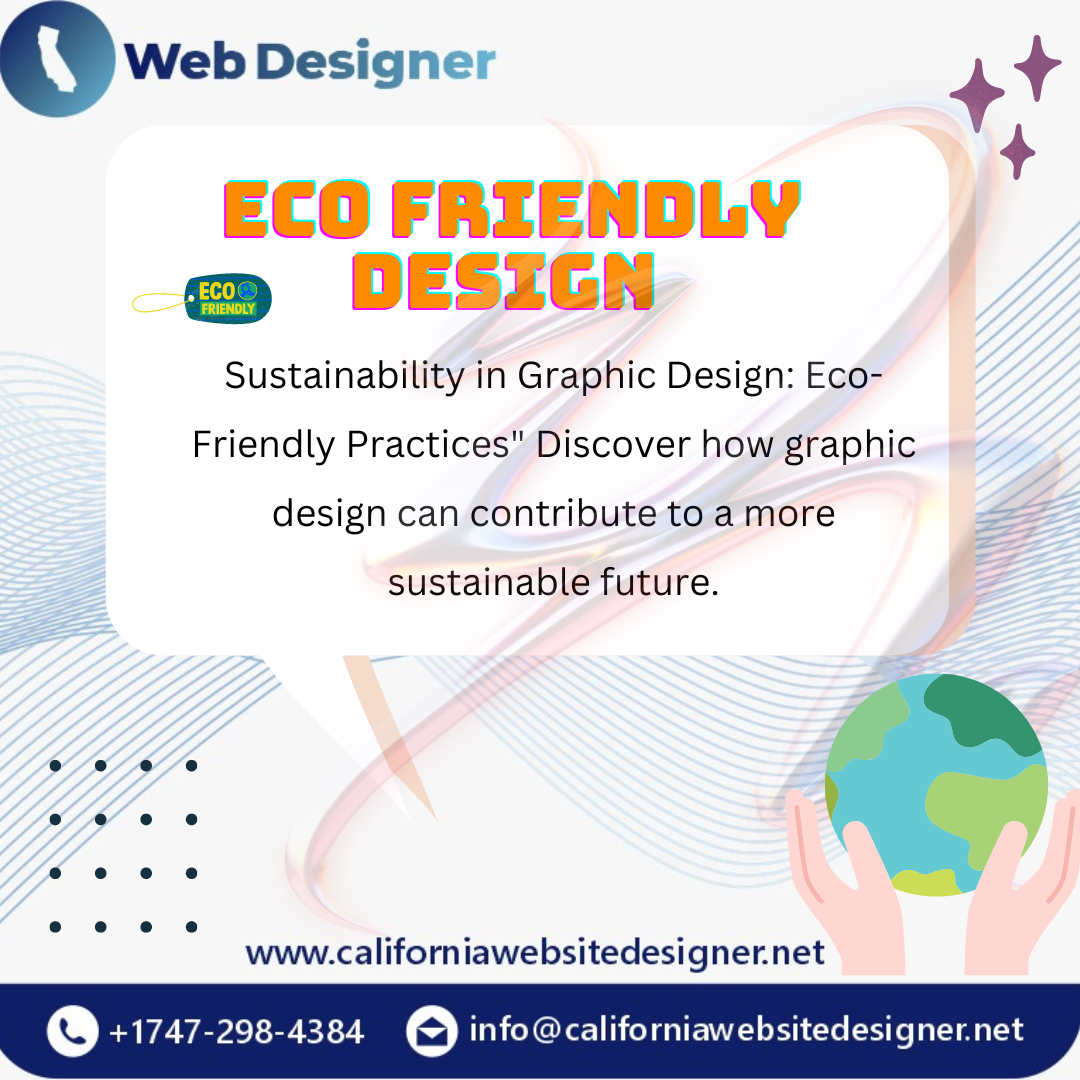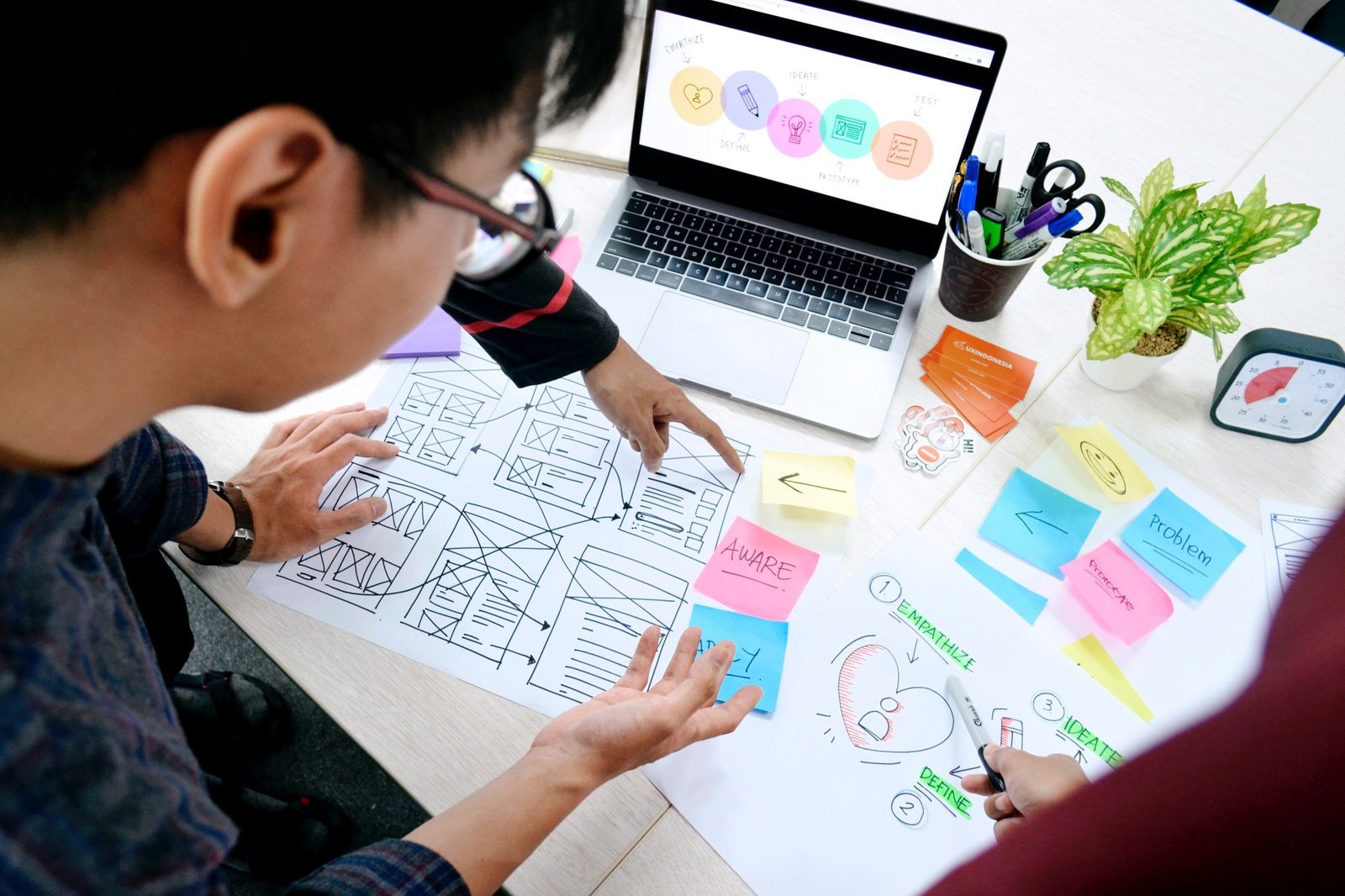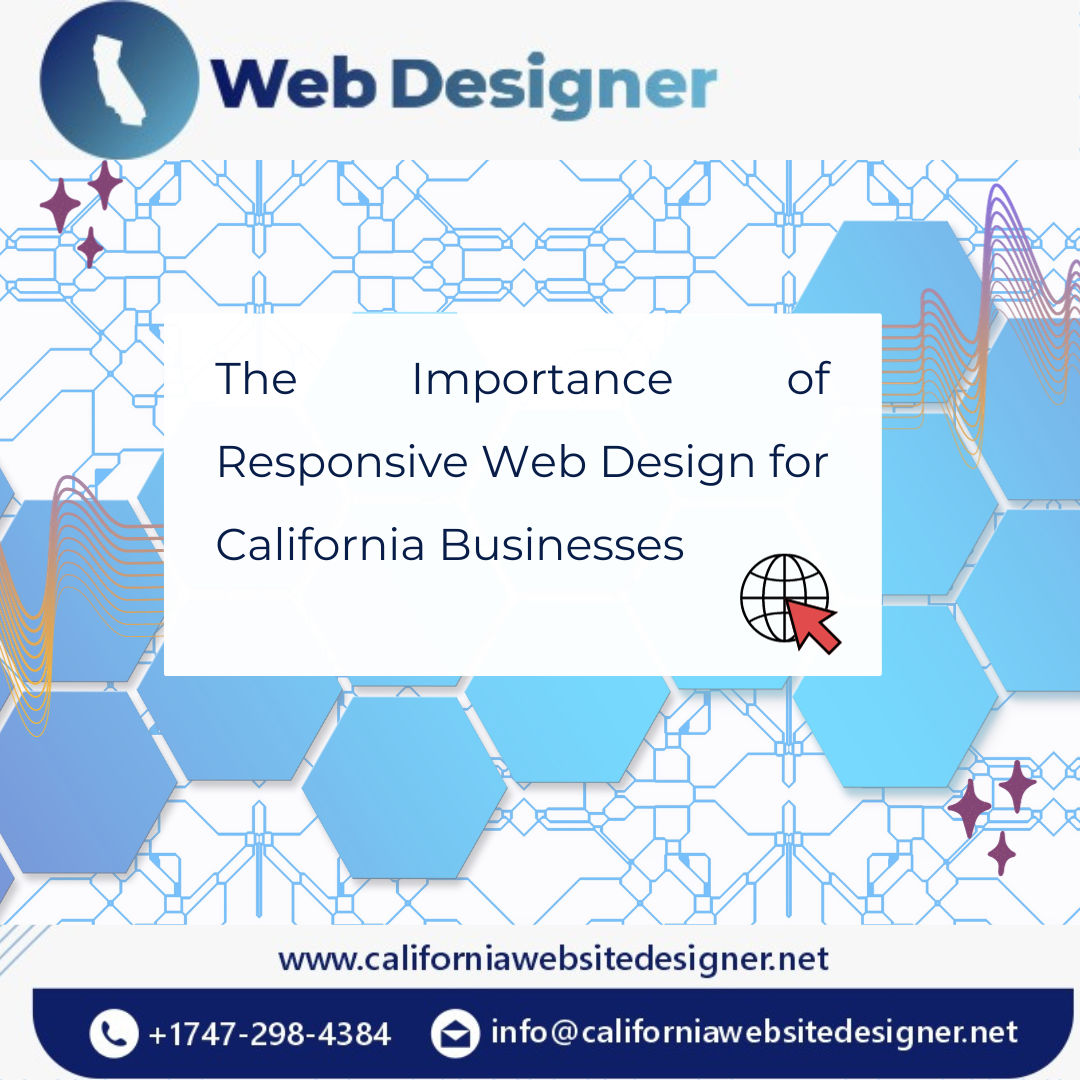Sustainability in Graphic Design: In today’s ever-changing world, graphic design shapes how we see things. With technology advancing, graphic design must match sustainability goals. Sustainability in graphic design ensures our creative choices don’t harm the planet. Let’s explore how the industry can make a positive impact, creating a visual landscape that’s both beautiful and eco-friendly.
Sustainable Materials in Graphic Design
Embracing Recyclable and Biodegradable Options
Graphic design has historically been associated with materials that leave a significant environmental footprint. However, a positive shift is occurring as the industry increasingly embraces sustainable alternatives. One key aspect is the adoption of recyclable and biodegradable materials.
Eco-Friendly Paper: A Breath of Fresh Air
Traditionally, graphic design heavily relied on paper produced through resource-intensive methods. In the pursuit of sustainability, designers are now turning to eco-friendly paper options. These papers are crafted from recycled materials or sustainably sourced wood, reducing the demand for virgin resources.
Biodegradable Inks: Coloring the Future Green
The inks used in graphic design are crucial in determining the industry’s environmental impact. Embracing biodegradable inks, mainly the ones derived from soy, gives a sustainable answer. Unlike traditional petroleum-primarily based inks, soy-based total inks are renewable, biodegradable, and emit fewer unstable natural compounds (VOCs), contributing to cleaner air.
Patagonia’s Sustainable Packaging
Patagonia, a renowned outdoor clothing company, exemplifies sustainability in graphic design. They shifted to using 100% recycled paper for their catalogs and adopted soy-based inks. This move aligns with their environmental values and sets a precedent for the industry.
Innovations in Printing Technologies
Advancements in printing technologies are reshaping the landscape of sustainable graphic design practices. The transition from conventional printing methods to digital alternatives is at the forefront of this positive change.
Digital Printing: Precision with Purpose
Digital printing offers a more sustainable alternative to traditional printing methods. It enables designers to produce precise and efficient prints, minimizing waste significantly. Unlike offset printing, which often results in surplus prints and excess waste, digital printing allows for on-demand production, reducing environmental impact.
Soy-Based Inks: A Renewable Palette
Soy-based inks have emerged as a sustainable alternative to traditional petroleum-based inks. These inks are derived from soybeans, a renewable resource. Beyond being biodegradable, they contribute to a reduction in greenhouse gas emissions during production, fostering a cleaner and greener graphic design industry.
Greenfield Paper’s Hemp Heritage
Greenfield Paper’s Hemp Heritage line showcases sustainable materials and printing technologies. Their products are crafted from 25% hemp and 75% post-consumer recycled content, utilizing soy-based inks. This combination exemplifies a commitment to both eco-friendly materials and printing processes.
Energy-Efficient Design Studios
Transitioning to Renewable Energy
Sustainability in graphic design extends beyond visuals—it encompasses the very processes that bring those visuals to life. Energy-efficient design studios are leading the charge in reducing their ecological footprint. By transitioning to renewable energy sources such as solar or wind power, these studios are not only aligning with sustainability goals but also setting an inspiring example for the wider business community.
Studio XYZ Goes Solar
One notable example is Studio XYZ, a forward-thinking graphic design studio that made the switch to solar power. By installing solar panels on their studio roof, they generate a significant portion of their energy needs sustainably. This move not only lowers their carbon footprint but also showcases a commitment to environmental responsibility. Clients and collaborators alike are drawn to Studio XYZ’s eco-friendly ethos, setting a positive precedent in the industry.
Investing in Energy-Efficient Equipment
In the pursuit of sustainability in graphic design, the choice of equipment matters. Energy-efficient design studios prioritize the use of equipment that minimizes energy consumption while maximizing output. LED lighting, energy-efficient computers, and eco-friendly printing equipment are among the investments that contribute to a more eco-friendly workspace.
Green Print Design Studio
Green Print Design Studio exemplifies the commitment to energy efficiency. They’ve invested in cutting-edge, energy-saving LED lighting throughout their workspace, reducing energy consumption without compromising the quality of their work. This not only saves on electricity costs but also positions Green Print as a leader in sustainable design practices.

Remote Work Practices
Reducing Commuting-Related Emissions
The graphic design industry has witnessed a significant shift towards remote work, bringing about positive implications for sustainability. One of the key benefits is the reduction in commuting-related emissions. Designers working from home contribute less to traffic congestion and air pollution, resulting in a more environmentally friendly approach.
Design Hub’s Virtual Collaboration Success
Design Hub, a prominent graphic design agency, embraced remote work and witnessed a remarkable decline in commuting-related emissions. By allowing designers to work from the comfort of their homes, Design Hub not only improved work-life balance but also actively participated in reducing the carbon footprint associated with daily commutes. This shift has been well-received by both the team and clients, showcasing the feasibility and benefits of remote work in the graphic design sphere.
Embracing Virtual Collaboration Tools
The adoption of virtual collaboration tools is a cornerstone of sustainable remote work practices in graphic design. These tools not only enhance efficiency but also align with eco-friendly principles by minimizing the need for physical workspaces. Video conferencing, cloud-based file sharing, and collaborative project management platforms enable seamless communication without the environmental cost of daily commutes.
Eco Collab Software Solutions
Eco Collab, a software solutions company catering specifically to the graphic design industry, provides a suite of virtual collaboration tools. These tools empower design teams to work together seamlessly, irrespective of geographical location. By reducing the need for in-person meetings and physical workspaces, Eco Collab contributes to a more sustainable graphic design ecosystem.
Remote work practices, as demonstrated by Design Hub and facilitated by tools like those provided by Eco Collab, underline the positive environmental effects of reduced commuting and virtual collaboration. As the graphic design industry continues to evolve, embracing these sustainable practices becomes not only a choice but a responsibility—one that contributes to a greener, more eco-conscious future.
Minimizing Waste in the Creative Process
Implementing Circular Design Principles
Sustainability in graphic design extends beyond choosing eco-friendly materials; it involves reshaping the entire creative process to minimize waste. Embracing circular design principles is a pivotal step towards achieving this goal. The circular design focuses on creating products with a life cycle that prioritizes durability, reparability, and recyclability.
Prioritizing Durability
Graphic designers can make a substantial impact by prioritizing the durability of their creations. By using robust materials and thoughtful design, they ensure that products withstand the test of time, reducing the frequency of replacements and, consequently, minimizing waste.
A notable example of prioritizing durability in graphic design is the Adidas Future Craft Loop sneaker. Crafted from a single material, the shoe is not only durable but designed for easy disassembly and recycling, embodying circular design principles.
Reparability and Recyclability
Encouraging reparability and recyclability in designs adds another layer of sustainability. Creating products that can be easily repaired extends their lifespan while prioritizing recyclability ensures that materials can be repurposed at the end of the product’s life.
The Fair phone, a sustainable smartphone, is designed with modularity in mind. Users can easily replace individual components, such as the battery or camera, reducing electronic waste and promoting reparability.
Digitalization and Reduced Physical Prototyping
The shift towards digitalization in the graphic design process represents a significant leap in minimizing waste. Traditionally, physical prototypes generate substantial material waste and contribute to environmental impact. The adoption of virtual prototypes not only accelerates the design timeline but also significantly reduces the need for physical samples.
Accelerating the Design Timeline
Digitalization allows designers to create virtual prototypes swiftly, streamlining the design process. This not only saves time but also minimizes the environmental footprint associated with physical prototyping.
The automotive industry has embraced digitalization to accelerate the design of vehicles. Virtual prototypes enable designers to assess aerodynamics, performance, and aesthetics without the need for numerous physical models, reducing both time and material waste.
Reducing Material Waste
Digital prototypes eliminate the need for excessive material consumption in the traditional prototyping phase. This reduction in material waste is a crucial aspect of sustainable graphic design practices.
In architecture, the use of Building Information Modeling (BIM) allows for the creation of detailed virtual prototypes of structures. This minimizes the need for physical models and construction waste, contributing to a more sustainable approach in the industry.
sustainability in graphic design requires a holistic approach, especially in minimizing waste during the creative process. By embracing circular design principles and leveraging digitalization for reduced physical prototyping, graphic designers can actively contribute to a more sustainable future.
Community Engagement and Education
Promoting Environmental Awareness
Graphic designers possess a unique ability to shape public perceptions and influence behavior through their creations. Harnessing this power for the betterment of the environment is a key strategy in promoting awareness about pressing ecological issues. By infusing sustainability messaging into their designs, graphic designers can effectively communicate the urgency of environmental concerns to the public.
Imagine a vibrant poster designed for a local environmental group. The poster features eye-catching graphics and compelling messages about reducing plastic waste and protecting biodiversity. This visually appealing design captures the community’s attention, sparking conversations and inspiring collective action.
Collaborating with eco-conscious organizations amplifies the impact of these efforts. By joining forces with environmental nonprofits, graphic designers can extend their reach and contribute to broader initiatives. This collaboration creates a ripple effect within communities, as shared values and messages resonate more strongly when delivered through diverse channels.
A graphic designer partners with a local environmental organization to create a social media campaign. The campaign includes visually appealing and shareable content that spreads awareness about sustainable living practices. The collaboration generates online discussions, encouraging community members to adopt eco-friendly habits.
Educational Initiatives for Designers
To ensure a sustainable future, investing in educational initiatives is crucial for cultivating a new generation of environmentally conscious graphic designers. These initiatives aim to equip designers with the necessary knowledge and skills to integrate sustainable practices into their creative processes effectively.
An online workshop designed for graphic designers focuses on incorporating eco-friendly principles into design projects. The workshop covers topics such as choosing sustainable materials, reducing carbon footprints, and creating designs that promote environmental stewardship. Participants gain practical insights and resources for implementing these concepts in their work.
Workshops, seminars, and online courses serve as accessible platforms for learning. These educational initiatives should be designed with simplicity in mind, ensuring that everyone, regardless of their background or expertise, can understand and apply the principles of sustainable design.
A local community college organizes a seminar series on sustainable graphic design. The sessions are structured to cater to beginners and experienced designers alike, breaking down complex concepts into easily digestible information. Attendees leave with practical tips on how to incorporate sustainability into their design projects.
The goal is to demystify sustainable design and make it approachable for all designers. Educational initiatives should emphasize the positive impact that small changes in design choices can have on the environment. By fostering a sense of responsibility and empowerment, these initiatives inspire designers to become advocates for sustainable practices in their professional endeavors.
A design school incorporates a module on sustainability in its curriculum. Students learn about the environmental impact of design choices and are encouraged to undertake projects that address real-world environmental challenges. This hands-on approach instills a sense of responsibility and creativity in the next generation of graphic designers.
Community engagement and education play pivotal roles in promoting environmental awareness among graphic designers. By integrating sustainability messaging into designs and investing in educational initiatives, designers can actively contribute to a more environmentally conscious and responsible creative community. Through collaboration and knowledge-sharing, graphic designers can leverage their skills to inspire positive change and contribute to a sustainable future.
Conclusion
The intersection of graphic design and sustainability is not only possible but essential for a brighter, eco-friendly future. By adopting sustainable materials, energy-efficient practices, waste reduction strategies, and community engagement, graphic designers, including those at California Website Designer, can actively contribute to a more sustainable world. Let us, at California Website Designer, embrace these practices collectively, ensuring that creativity and conservation coexist harmoniously in the realm of graphic design. Together, we can pioneer a positive change in the industry, setting an example for a more environmentally conscious approach to design.

Frequently Asked Questions
Q1. What is sustainable graphic design?
Sustainable graphic design involves creating visual content while minimizing environmental impact. It specializes in green materials, electricity-efficient tactics, and waste reduction, contributing to a more sustainable destiny.
Q2. How can photo designers use recyclable materials?
Graphic designers can opt for recyclable materials such as paper and ink in their projects. Choosing materials that can be recycled or biodegraded helps reduce the carbon footprint associated with traditional design processes.
Q3. What role does digital printing play in sustainable graphic design?
Digital printing is a game-changer in sustainability. It allows for precise production, minimizing waste compared to traditional methods. Additionally, the use of soy-based inks in digital printing enhances its eco-friendly credentials.
Q4. How can graphic design studios harness renewable energy?
Graphic design studios can transition to renewable strength sources like sun or wind power. This no longer most effectively reduces the environmental effect however additionally units an instance for different industries to follow match.
Q5. What is circular layout, and the way does it apply to graphic layout?
Circular design involves creating products with a life cycle that minimizes waste. In graphic design, this translates to prioritizing durability, reparability, and recyclability in the creation of visual content.
Q6. How does remote work contribute to sustainability in graphic design?
Remote work in graphic design reduces commuting-related emissions. Embracing virtual collaboration tools not only enhances efficiency but also aligns with sustainable practices by minimizing the need for physical workspaces.
Q7. Can graphic designers influence public perception of environmental issues?
Yes, graphic designers wield the power to shape public perception. By incorporating sustainability messaging into their designs, they can effectively raise awareness about environmental issues and inspire positive action.
Q8. How can collaborations with eco-conscious organizations benefit graphic designers?
Collaborating with eco-conscious organizations amplifies the impact of sustainable graphic design. It creates a ripple effect within communities, fostering a collective commitment to environmentally friendly practices.
Q9. Are there examples of successful sustainable graphic design campaigns?
Yes, notable examples include the “Paper Bottle” campaign by Coca-Cola, emphasizing recyclability, and the “Eco-Friendly Packaging” initiative by Apple, showcasing sustainable packaging design practices.
Q10. What educational initiatives are available for graphic designers interested in sustainability?
Numerous workshops, seminars, and online courses focus on integrating sustainability into graphic design practices. These initiatives equip designers with the knowledge and skills needed to create a positive environmental impact.







